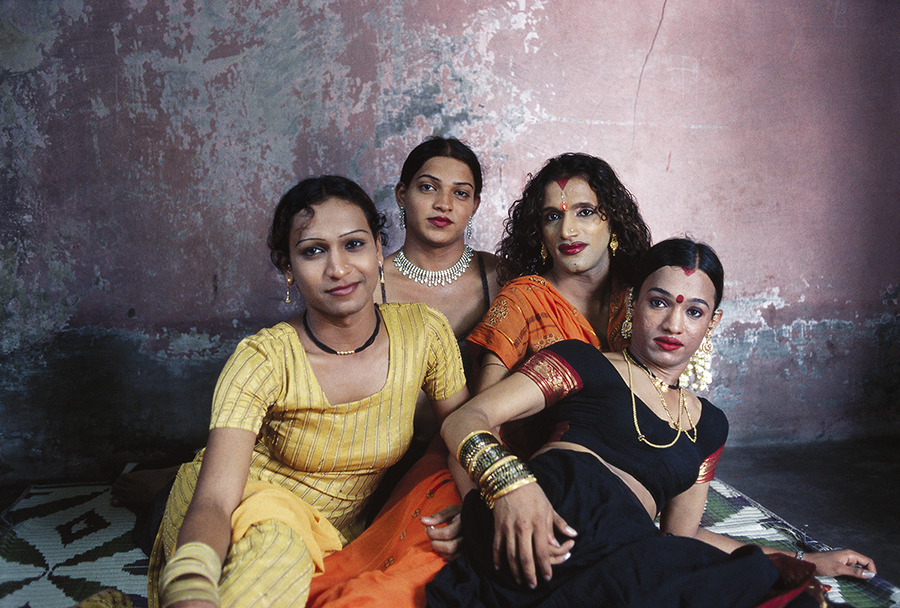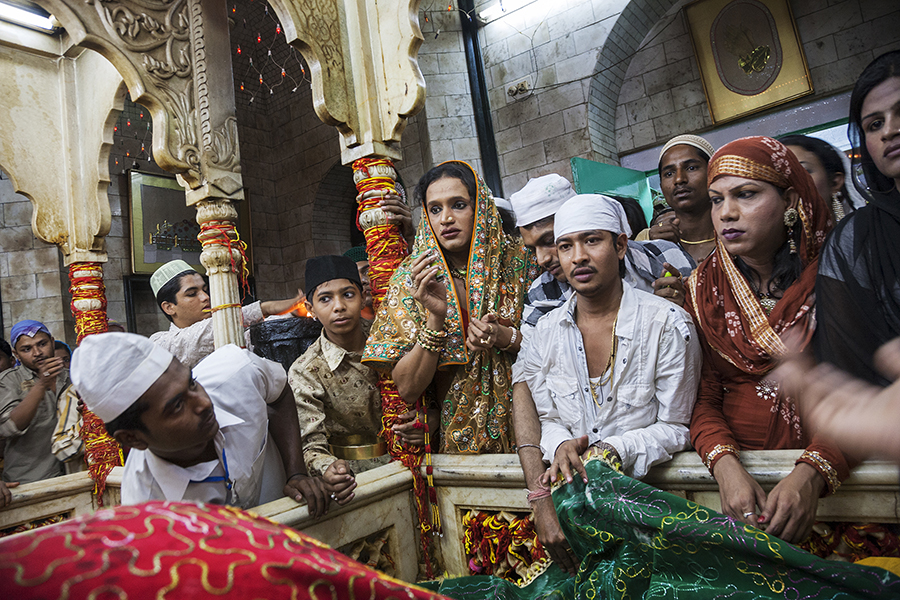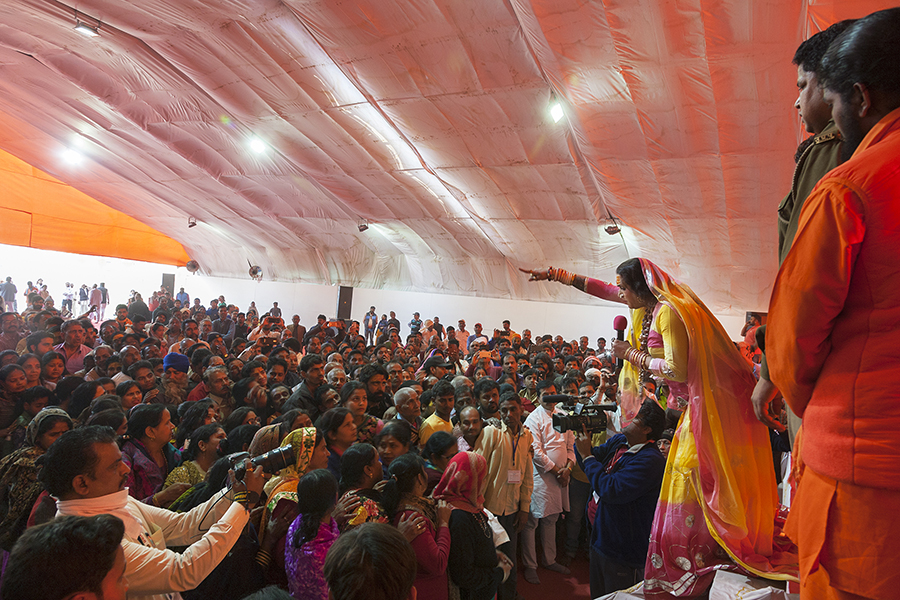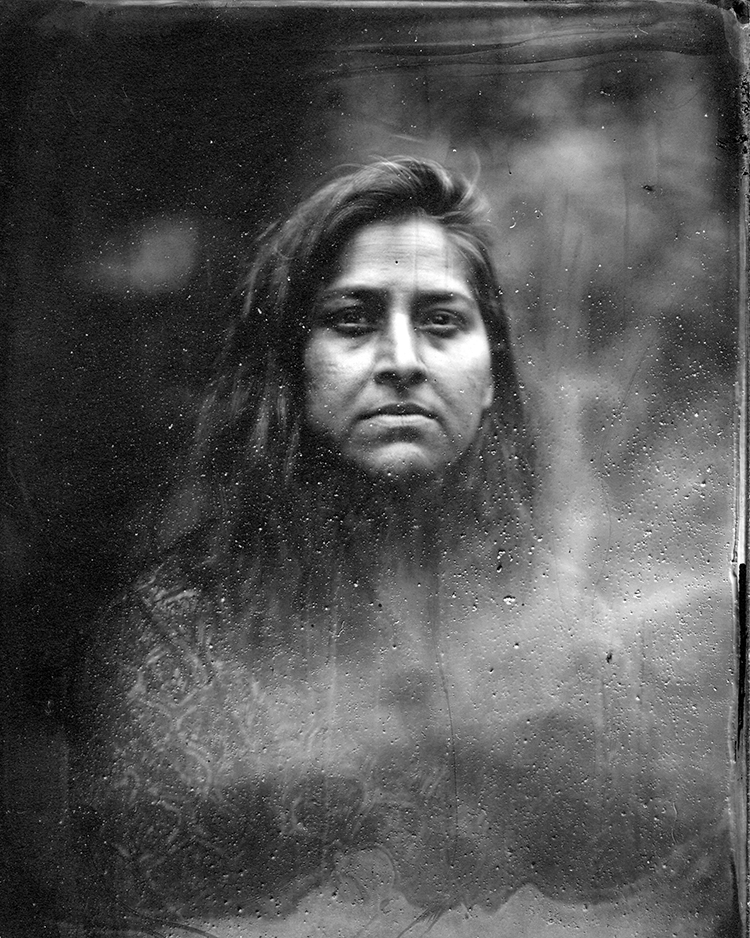[zoomsounds_player artistname=”In Laxmi’s Voice” songname=”An Inexplicable Cord” dzsap_meta_source_attachment_id=”9883″ source=”http://hundredheroines.org/wp-content/uploads/2021/03/Laxmi-Shorter-Clip-with-Intro_Outro.mp3″ config=”Audio-Resonses” ]
Anita Khemka discusses her work with the hijra community in India, her friend Laxmi, and her artistic process.
Hijras have often been a source of curiosity and fascination. While generally born male, they are officially recognised as a third gender in India, being considered neither male nor female. Some members of the community undergo the ritualistic castration ceremony known as nirvana which is considered a rebirth. A hijra’s presence and role in society has been documented in religious and mythological texts. One of the prevailing myths is that their blessings as well as their curses can come to fruition. One can find them dancing at weddings and at the birth of a baby in return for money and gifts.
Sadly, this community of people face oppression, ridicule and persecution daily. Despite the Transgender Persons (Protection of Rights Act 2019), many hijras live on the fringes of society and take to begging or sex work to support themselves. In the face of this oppression, Laxmi Narayan Tripathi (known as Laxmi) has embraced her hijra identity and become an activist campaigning for the equality and welfare of transgender individuals.
Contemporary Heroine Anita Khemka has spent two and a half decades photographing members of the hijra community, including Laxmi, with whom she has developed a strong bond. On the occasion of International Transgender Day of Visibility (March 31), she discusses her experience of working with the hijras and her friend, Laxmi.
Between The Lines: India’s Third Gender (dir.Thomas Wartmann, 2005) offers an incisive look into the hijra community of Mumbai, India, exploring their friendships, hardships, and sources of income. Joining the project to help Wartmann understand the community, Anita eventually appeared in the film herself as an on-screen documentarian. The film led to an ongoing personal and professional relationship between Anita and the transgender/hijra rights activist Laxmi Narayan Tripathi, whom she continues to photograph. The documentary can be accessed via communication with Thomas Wartmann.
I start to feel like one of them and they can see that this change is not a flattery or fakery, but a genuine celebration and embracing of the hijra culture and the community.
Shyama Laxman: In the documentary Between the Lines, you said that a group of hijras were your neighbours and your grandmother would issue a threat if you were being naughty—that you would be sent to live with them. What was your earliest recollection of encountering a hijra? And did this initial conditioning by family impact how you were to look at them as an adult?
Anita Khemka: Munna Guru was one of the first people that I photographed. She lived a few houses down my grandmother’s house and there was this unspoken history we shared. I think my grandmother had unknowingly created an inexplicable cord between us and it just needed to be explored. Without ever meeting her as a child, I grew up in fear of her. Her loud voice, aggressive body language, and facial hair was all quite intimidating. It was during my teen years that my fears turned to curiosity when I discovered that she was a hijra, a eunuch. The ambiguity of her gender fascinated me as I was at the stage of exploring my own, and perhaps that was the cord I was willing to explore. What was it like to be born without a defined sex; to be addressed as ‘she’ one moment and ‘he’ the next?
When I picked up the camera in 1995, I went knocking on her door and even though fifteen years had passed, she recognised me instantly. I told her that I had picked up the camera recently and wanted to photograph her life. She indulged me completely and generously. I would spend days with her, sometimes pressing the shutter of the camera only once. I was never in a hurry or felt the desperate need to photograph everything that she was doing. I think the camera gave me power. Mere possession of it made me comfortable and I think it had an effect on her and her cohort as well. I suddenly had a capability that eased me and helped me to address and confront a fear that I had grown up with.
I photographed Munna Guru until her death in 2003. During this period, she welcomed me into her home in Delhi where she lived with her chelas; often taking me to Turkman Gate and Ajmeri Gate, walking through the lanes and by lanes of old Delhi. She loved showing off to people that she was being photographed, talking about it with old friends that I had “found” her, perhaps reliving for the last time her past glory, just as the last glow before a candle extinguishes.
SL: How did Between the Lines come to you and what was your preparation like? Did you have any reservations before you started?
AK: My father passed away in 2003, a few months after Munna Guru’s death. It was around the same time that Thomas Wartmann reached out to me to assist him with the making of the film, after having had a difficult time working with hijras. Reluctantly, I agreed as I thought it would help me take my mind away from the loss, especially my father’s. I agreed to assist Thomas, not knowing that he would eventually cast me in his film. My role in the film evolved with each day, from a support person helping the director to understand and communicate with the community to finally the director following me as I navigated the Hijra community in Mumbai as a documentarian. It was a role I certainly performed with great ease having documented Munna Guru in Delhi for 8 years. And it’s here that I ‘found’ Laxmi — someone who I would continue to photograph, even until today.
SL: Your language while talking to the hijras is very informal, as though you are conversing with friends. At one point in the film you say that you have begun speaking like them. Did that happen naturally?
AK: The shooting of the film happened twice for a period of two weeks, six months apart. However, it did not come to me naturally to just go in with a team, a foreign one at that, and work for two weeks only. I cannot work without a connection, and a connection can only be formed with persistence, patience and with a personal investment of one’s self. So it was important for me to spend time with them, live with them and travel with them. I think I started miming them sometime during this period and even today I switch into their lingo the moment I am in a conversation with them. I start to feel like one of them and they can see that this change is not a flattery or fakery, but a genuine celebration and embracing of the hijra culture and the community.
SL: In the public domain, people see Laxmi as a ‘larger than life’ figure. She is beautiful, her words command attention, and she defies the stereotypical expectations of what a hijra is or should be, especially in India. What was your initial impression when you met her? During the course of the film did you feel that she would become a globally renowned figure?
AK: When I first met Laxmi Narayan Tripathi, I saw a very intelligent, smart, earnest and enterprising young person. She had the gift to grab the moment and the education and eloquence to articulate her thoughts well. More than anything else, she was bold and concerned about her community. It is easy now to say in hindsight that yes, she had all the elements to succeed, but as a fellow traveller, I know it has been extremely difficult and has taken a lot of hard work and guts of steel for her to reach where she has. Honestly speaking, I had not expected her to become such a renowned figure internationally in spite of all the qualities she possesses. This is mostly because no one else from her community had done it before and it was not easy to visualise that it could even be possible.
SL: In the documentary, Laxmi says that hijras are privileged compared to women, because they are sexually expressive and have fewer restrictions. What did you make of her views on women versus hijras?
AK: This is a very complex thought. At the root I believe is a male gaze being transformed into a feminine expression. My empirical understanding is that being forced to live a certain part of their life in a male embodiment, there is an underlining understanding of the male expectations, overtures, and aggressiveness which finds voice in loud and unhindered sexual instinct. The hijras navigate both the male and the female end of the society and so are very well informed of the repression of the female sex as well as the basal male craving. I think by privilege, Laxmi means this understanding, and the ability to play it out without any limitations or social veneer.
SL: You have said that it was sometime before Laxmi began trusting you. What is the trust-building process like?
AK: I’d like to add here that it took me sometime as well to trust Laxmi. We both started out with certain distrust towards each other, and as Laxmi would say it, with “hate”. In my opinion, it’s about trying to give more than you take that establishes trust; it’s about making yourself equally available and laying yourself bare, with all your vulnerabilities, inadequacies and insecurities. Laxmi is very smart, and would never let herself be exploited as has happened unfortunately with the community for far less. She was being conscientious.
SL: Some of the images in your series on Laxmi are very intimate. How did you ensure that the ‘gaze’ did not objectify your subjects?
AK: Any gaze is the outcome of your motivation to photograph and the relation you share with your subject. My work is drawn out of personal concerns and is a response to the reality around me. All my personal works are very long term and continue for years, as in the case with Laxmi, which has been going on for 17 years now. Such work will become repetitive and redundant if the nuances of the subject are not visible to your own eye. I think it is my need to live through the experiences of my subject (in this case Laxmi) in order to make a meaningful image which keeps me true to my purpose. I spend hours and days with Laxmi without photographing her.
SL: Did Laxmi have any inputs on her photographs or the creative process?
AK: Laxmi totally understands the importance of documentation and she knew this instinctively from very early on. She also understands the importance of the image being projected out. Technically, she has a good sense of aesthetics and presence, having been in front of the camera for so many years. There are times when she prompts me to make her photographs. There are in between days when I just let the camera lie quietly between her and me. The work I am making with Laxmi is a collaboration and we communicate, not necessarily in the obvious ways.
SL: Did you encounter any obstacles or safety issues while working on the project?
AK: Laxmi is extremely protective of me, so there have never been any safety issues. However, there have been many obstacles. The obstacles have mainly come from my need to explore her relationship with the larger hijra community which has a very stiff and rigid structure. As she has grown in stature, and our collaboration has deepened, we have slowly overcome many obstacles.
SL: Describing your relationship with Laxmi, you have said that you ‘will continue photographing her until one of us dies’. What binds you so strongly to Laxmi and this project?
AK: As life would have it, I started photographing Laxmi right after Munna Guru passed. Munna Guru had been an old guard in Delhi, pretty well enshrined in the traditional structure. My introduction to her relations with her mother and sister stirred something inside of me and I so wanted to understand how Munna Guru’s life had passed through these stages from youth till her end. Laxmi was young, lively and fresh in 2003 and I thought I had found a young Munna. But then Laxmi took a route which put her on the most interesting and fascinating journey. She transformed from being Raju, to Laxmi the diva, and now to Laxmi the Acharya Mahamandaleshwar. Sustaining such a long relationship is possible when there is genuine friendship and commitment which involves breaking of walls and laying yourself as bare as you expect your subject to be. There have been huge parallels in our personal lives, and times where we have met to just unburden ourselves. This has also ensured that our work becomes more meaningful and not another cliché.
In the close to two decades that I have known her, I have seen her life move from troughs to crests and on and on. I think the perfect end to this journey will be the passing of one of us … I think that will complete the story.
SL: Lastly, any advice for women wanting to enter the field of photography?
AK: My advice to people who would like to begin a practice in documentary photography would be to major in at least one area of study such as Philosophy, Sociology, Economics, Anthropology or even Pure Sciences. And equally important would be to not put the burden of making a living on their personal practice as this totally compromises the work.
all images ©️ Anita Khemka / PHOTOINK















